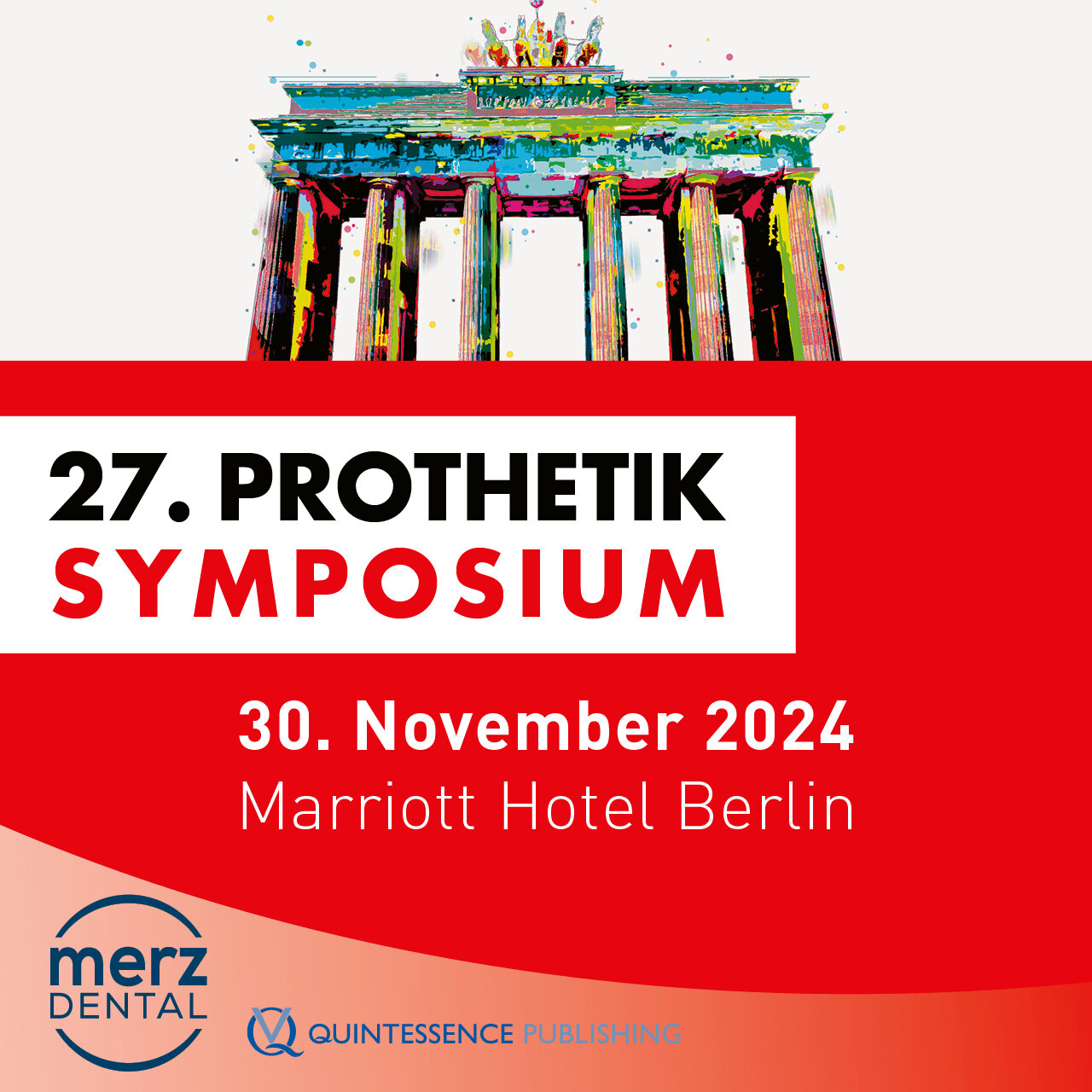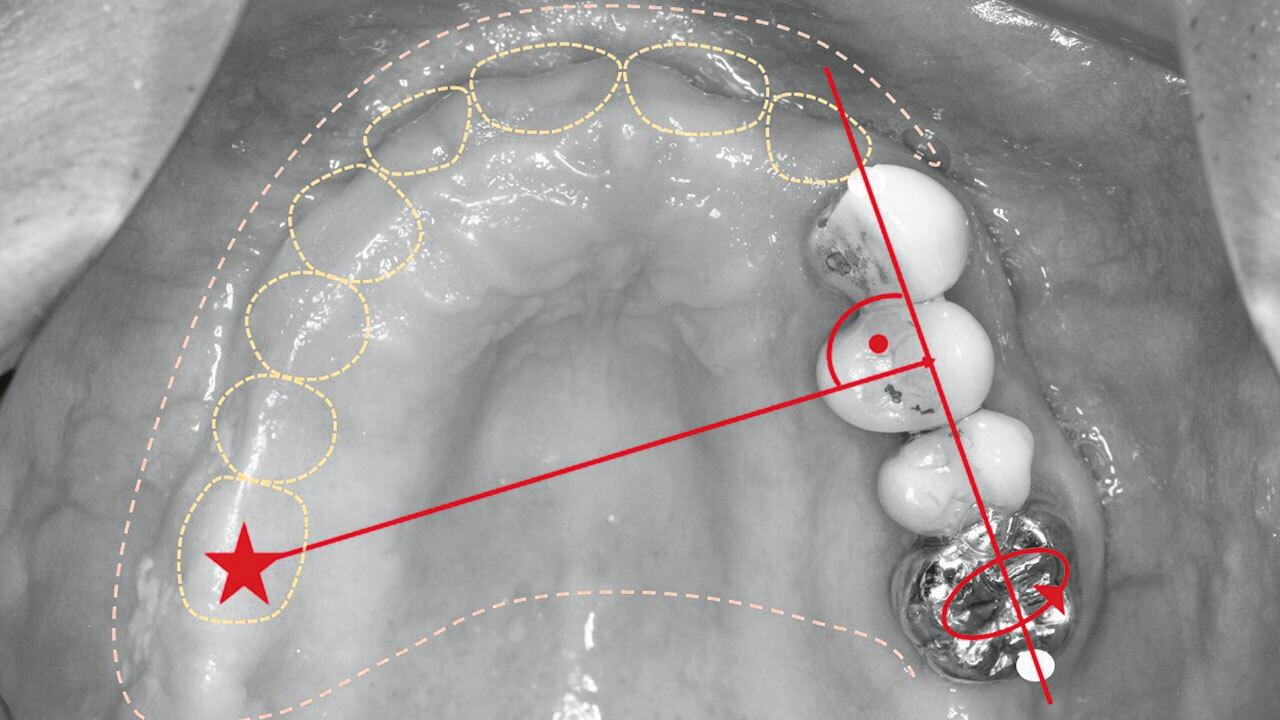The Journal of Adhesive Dentistry, 1/2025
Open Access Online OnlyCLINICAL MEDICINEDOI: 10.3290/j.jad.c_1871, PubMed ID (PMID): 4006307710. Mar 2025,Pages 21-29, Language: EnglishReymann, Josephine / Narayanan Ramakrishnan, Anantha / Ludtka, Christopher / Hey, Jeremias / Kiesow, Andreas / Schwan, StefanPurpose: The current trend in denture adhesives is shifting toward zinc-free formulations due to the significant health concerns associated with zinc. Studies have focused on the retention of these zinc-free denture adhesives; however, there is a dearth of literature regarding their damping performance. This study analyzes the impact of oral cavity physiological parameters: temperature, pH, and swelling ratio on the mechanical properties of zinc-stabilized and zinc-free denture adhesives and examines the role zinc plays in influencing the adhesive behavior. This study investigates how underlying mechanical properties of adhesive cream change for zinc-stabilized and zinc-free denture adhesives. The relative damping and its variation from exposure to physiological conditions in the oral cavity can significantly assist in the design of dentures to reduce the discomfort experienced by denture wearers. Materials and Methods: The relative damping of the zinc-stabilized and zinc-free denture adhesives was investigated with the loss modulus values, which were evaluated using rheological frequency sweep tests. The tests were performed by maintaining the denture adhesives at specified values of temperature, pH, and swelling ratio, and over a frequency range of 0.01 Hz to 10 Hz, which included the average frequencies of human chewing / bite forces reported in existing literature. Results: Zinc-stabilized denture adhesive showed a larger fluctuation of loss modulus values compared to the zinc-free formulation with respect to pH, temperature, and swelling ratios. The zinc-free denture adhesive showed higher damping behavior at frequencies below 0.7 Hz, whereas the zinc-stabilized denture adhesive showed higher damping behavior above loading frequencies of 0.7–1 Hz. Both the adhesives showed varying behavior on either side of the bite force spectrum in terms of relative damping of the applied bite. Conclusions: The damping or cushioning effect provided by denture adhesives can reduce pain experienced and assist dental practitioners in better supporting denture wearers.
Keywords: bite force, damping, denture retention, physiological parameters, zinc-free denture adhesive
International Journal of Computerized Dentistry, 4/2024
ScienceDOI: 10.3290/j.ijcd.b4451424, PubMed ID (PMID): 37823541Pages 379-388, Language: English, GermanPrause, Elisabeth / Schmidt, Franziska / Unkovskiy, Alexey / Beuer, Florian / Hey, JeremiasAim: The adjustment and transfer of a stable occlusion can be a major challenge in prosthetic rehabilitations. The aim of the present study was to assess a noninvasive treatment option for complex prosthetic rehabilitations and occlusal analyses using 3D-printed restorations clinically. Materials and methods: Eleven patients received a partial or complete rehabilitation with the aid of 3D-printed restorations (n = 171). After 12 months of clinical service, all restorations were analyzed using the United States Public Health Service (USPHS) criteria. Results: The 12-month clinical data revealed that 3D-printed restorations showed a survival rate of 84.4%. Complications occurred mostly regarding the anatomical form (7%) or marginal integrity (6%) and were consequently rated “Charlie” or “Delta.” Color stability and color match of 3D-printed restorations were rated “Alpha” in 83% and 73%, respectively, of all restorations. Marginal inflammation was rated “Alpha” in 89% of all restorations. An excellent surface texture and no secondary caries or postoperative sensitivities (100%) were observed. Conclusions: 3D-printed restorations might be an alternative treatment option for initiating complex prosthetic rehabilitations. Technical complications rarely occurred. Biologic complications did not occur at all. The color stability showed promising results after 12 months of clinical service. However, the results should be interpreted with caution until long-term results with a high number of restorations are available.
Keywords: 3D-printing, additive manufacturing, color stability, wear behavior, in vivo, CAD/CAM
Quintessence International, 9/2023
DOI: 10.3290/j.qi.b4366813, PubMed ID (PMID): 37724999Pages 746-749, Language: EnglishKohnen, Luisa Valentina / Beuer, Florian / Hey, Jeremias / Adali, UfukObjectives: Addressing a single-tooth gap in the anterior region, resulting from aplasia or trauma, poses both esthetic and functional challenges. This case report presents the restoration of a young adult with a cleft, exhibiting anterior hypoplasia and aplasia in the canine and incisor regions, using all-ceramic cantilever resin-bonded fixed dental prostheses.
Method and materials: After verification of esthetic and functional considerations through a diagnostic wax-up and an intraoral mock-up, three anterior all-ceramic cantilever resin-bonded fixed dental prostheses made of veneered zirconium dioxide were planned in the region of the maxillary right lateral incisor and maxillary left canine. The impression was made with an intraoral scanner. The framework fit was evaluated. Glaze firing and full adhesive cementation under rubber dam followed.
Results: The final restoration met the patients’ expectations and restored facial esthetics and function.
Conclusions: All-ceramic cantilever resin-bonded fixed dental prostheses offer a promising minimally invasive therapeutic option for cleft patients.
Keywords: aplasia, cantilever, cleft of lip and palate, prosthodontics, resin-bonded fixed dental prosthesis (RBFDP), veneered zirconium dioxide
Deutsche Zahnärztliche Zeitschrift, 5/2023
WissenschaftPages 320-328, Language: GermanPrause, Elisabeth / Nicic, Robert / Beuer, Florian / Hey, JeremiasFallberichtEinführung: Die Rekonstruktion generalisierter Zahnhartsubstanzdefekte stellt eine therapeutische Herausforderung dar. Vor mehr als zehn Jahren wurden Konzepte auf der Basis von noninvasiven Vorgehensweisen veröffentlicht. Die aufwendige Vorgehensweise verhinderte einen flächendeckenden Einsatz. Die additive Fertigung eröffnet dafür neue Chancen. In einer klinischen Untersuchung wird die Bewährung gedruckter Aufbisse aus Hybridmaterial validiert. Exemplarisch für diese Studie wird im Folgenden ein Patientenfall erläutert.
Behandlungsmethode: Im dargestellten Patientenfall bestand die Problematik eines generalisierten, ausgeprägten Erosionsgebisses. Die Rekonstruktion basierte auf einem volldigitalen Workflow und führte zu 27 gedruckten Aufbissen im Non-prep-Design aus einem Hybridmaterial. Nach Eingliederung erfolgten eine Farbbestimmung mittels Spektralfotometers sowie ein Intraoralscan zur Beurteilung des Verschleißverhaltens. Beide Maßnahmen wurden nach sechs, zwölf, 24 und 36 Monaten wiederholt.
Ergebnisse: Nach zwölf Monaten Tragezeit wurden ein durchschnittlicher Materialverschleiß von 0,09 mm und eine Farbveränderung von ΔE = 6,3 ± 2,3 ermittelt. Zudem kam es zu drei Abplatzungen.
Schlussfolgerung: Das Patientenbeispiel zeigte die Verwendung gedruckter Hybridmaterialien als noninvasive Therapiemaßnahme. Eine schnelle Verbesserung der Ästhetik, verbunden mit einer Bisshebung, wurde ohne eine langwierige Vorbehandlung mittels Bisshebungsschiene erreicht. Zur weiteren Beurteilung der Behandlungsoption müssen die Ergebnisse einer größeren Kohorte über einen längeren Zeitraum abgewartet werden.
Keywords: 3D-Druck, Abrasion, additive Fertigung, Bisshebung, CAD/CAM, Erosion
International Journal of Computerized Dentistry, 3/2023
ScienceDOI: 10.3290/j.ijcd.b3796761, PubMed ID (PMID): 36632987Pages 247-255, Language: English, GermanPrause, Elisabeth / Hey, Jeremias / Sterzenbach, Guido / Beuer, Florian / Adali, UfukA 10-year follow-up studyAim: The aim of the present study was to evaluate the long-term clinical survival and success rate of veneered zirconia crowns with a modified anatomical framework design after 10 years in function.
Materials and methods: In total, 36 zirconia crowns were fabricated for 28 patients. An anatomically modified framework design was developed. Crowns were inserted between 2008 and 2009. A follow-up of 19 patients with 28 crowns was conducted in 2020 to document mechanical and biologic parameters. Additionally, a modified version of the pink esthetic score (PES) was documented. Patient satisfaction was assessed using United States Public Health Service (USPHS) criteria. The success and survival rates were calculated using the Kaplan-Meier analysis.
Results: After more than 10 years of clinical service, the survival rate of the zirconia crowns was 92.9%. Biologic complications occurred in 12% of the examined crowns, whereas technical complications occurred in 54%. Mostly, chippings (50%) and insufficient marginal gaps (50%) were observed. Most crowns were positively evaluated for more than one technical complication. Periodontal conditions with probing depths of up to 3 mm were comparable with measured values before crown delivery (73% to 75%). Most of the crowns had modified PES values of 10 or higher. Patient satisfaction was high.
Conclusions: The modified framework design led to a high survival rate of the crowns but a relatively low success rate. High patient satisfaction and inconspicuous periodontal conditions were demonstrated. Biologic complications occurred far less frequently than technical complications.
Keywords: all-ceramic crown, framework design, clinical study, chipping, complications
Quintessence International, 6/2022
DOI: 10.3290/j.qi.b2793257, PubMed ID (PMID): 35274516Pages 534-545, Language: EnglishJennes, Marie-Elise / Hey, Jeremias / Bartzela, Theodosia N. / Mang de la Rosa, Maria R.The treatment management of patients with hemifacial microsomia (HM) includes both surgical and nonsurgical approaches and depends primarily on the degree of deformity of the facial and skeletal structures. In this context, the combined efforts of the maxillofacial surgeon, the orthodontist, and the prosthodontist are essential for a satisfactory functional and esthetic outcome.
Case presentation: A 31-year-old man presented with a chief complaint of facial asymmetry. The patient had been diagnosed with HM on the right side, with severe external ear deformity, and hypoplasia of the facial muscles and the zygomatic bone. The intraoral examination showed a Class I molar and canine relationship with a reduced horizontal overlap and an occlusal plane canting. The maxillary anterior teeth were severely worn due to traumatic occlusion. Orthodontic treatment in conjunction with combined orthognathic surgery was planned to address the facial asymmetry. Ramus distraction osteogenesis was carried out, followed by conventional presurgical orthodontic treatment. The treatment was completed by prosthetic rehabilitation for the reconstruction of the maxillary teeth and fine occlusal adjustment.
Conclusion: The cooperation between the orthodontist, surgeon, and prosthodontist becomes indispensable when treating complex cases of HM. An interdisciplinary approach should be adopted from the start of treatment, promoting integrated customized care.
Keywords: functional rehabilitation, hemifacial microsomia, interdisciplinary treatment, orthodontics, prosthodontics
QZ - Quintessenz Zahntechnik, 12/2022
ErfahrungsberichtPages 1252-1259, Language: GermanNicic, Robert / Prause, Elisabeth / Hey, JeremiasDurch die Weiterentwicklung der additiven Fertigung in der Zahnmedizin können heute ästhetisch ansprechende, kostengünstige Einzelzahnrestaurationen schnell und ressourcenschonend hergestellt werden. Der vollständig digitale Behandlungsablauf wird in diesem Fallbericht erläutert.
Keywords: CAD/CAM, additive Fertigung, 3-D-Druck, digitaler Workflow, Intraoralscan
DZZ International, 1/2022
Open Access Online OnlyReviewDOI: 10.53180/dzz-int.2022.0002Pages 11, Language: EnglishMewes, Louisa / Hey, Jeremias / Adali, UfukPeri-implantitis is a plaque-associated pathological disease occurring in tissues surrounding dental implants. It is characterized by an inflamed peri-implant mucosa and resulting progressive loss of peri-implant supporting bone. Prosthodontic etiologic factors such as hygiene-incompetent prosthetic designs or residual cement seem to favor the development of peri-implantitis. During the course of the article, several characteristics of prosthetic superstructures are presented and their relevance in relation to peri-implant inflammation is discussed.
Keywords: implants, peri-implantitis, prosthetic, superstructure
Deutsche Zahnärztliche Zeitschrift, 1/2022
WissenschaftDOI: 10.53180/dzz.2022.0005Pages 37, Language: GermanMewes, Louisa / Hey, Jeremias / Adali, UfukDie Periimplantitis ist eine plaqueassoziierte pathologische Erkrankung, die in Geweben um Zahnimplantate auftritt. Sie ist durch eine entzündete periimplantäre Mukosa und einen daraufhin fortschreitenden Verlust von periimplantären Stützknochen gekennzeichnet. Prothetisch ätiologische Faktoren wie hygieneunfähige Zahnersatzgestaltungen oder verbliebene Zementreste scheinen die Entstehung einer Periimplantitis zu begünstigen. Im Verlauf des Artikels werden mehrere Merkmale prothetischer Suprakonstruktionen vorgestellt und ihre Bedeutung im Zusammenhang mit periimplantären Entzündungen wird diskutiert.
Keywords: Implantate, Periimplantitis, Prothetik, Suprakonstruktion
International Journal of Computerized Dentistry, 4/2021
ApplicationPubMed ID (PMID): 34931779Pages 439-448, Language: English, GermanAdali, Ufuk / Peroz, Simon / Schweyen, Ramona / Hey, JeremiasThe majority of complete dentures are not initially made for the rehabilitation of an edentulous jaw; in most cases, they replace an existing complete denture. Since the ability to adapt to a new complete denture decreases with age, the replica denture procedure represents a smart opportunity. The aim is to copy the clinically successful parts of the old prosthesis and to change the destroyed parts. There are many advantages of this technique, including increased patient acceptance, especially among older people who may not be able to adapt easily to a new prosthesis. The advantages of digital technology are very apparent in the creation of a replica prosthesis. Various cases are presented in the present article to illustrate the procedure and the advantages of this technique using the example of computer-aided fabrication with the Baltic Denture System.
Keywords: CAD/CAM, complete dentures, milled prosthesis, replica denture








